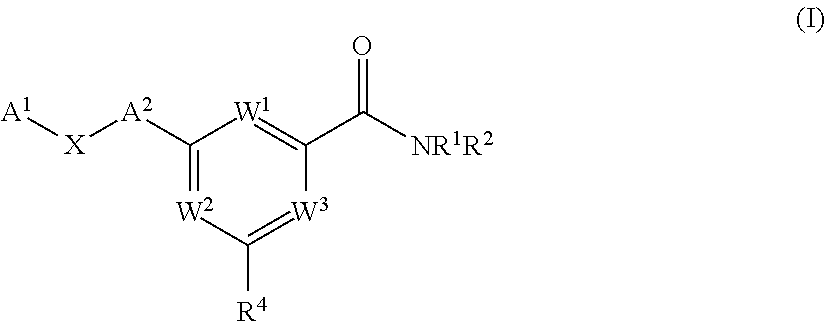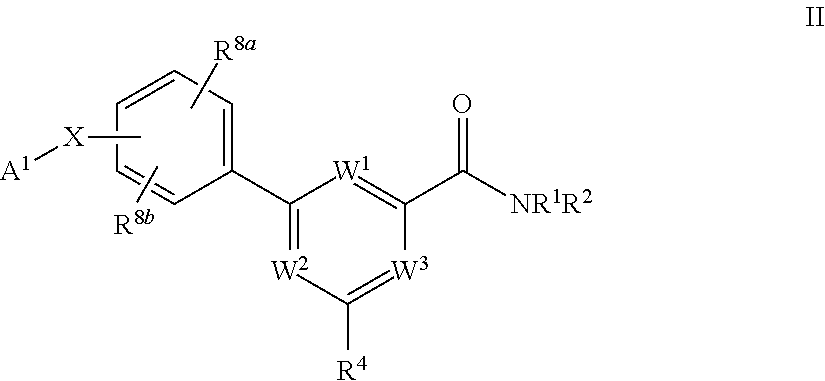Pyrimidine diol amides as sodium channel blockers
a technology of pyrimidine diol amide and sodium channel blocker, which is applied in the field of medicinal chemistry, can solve the problems of many undesirable side effects of the currently available treatments
- Summary
- Abstract
- Description
- Claims
- Application Information
AI Technical Summary
Benefits of technology
Problems solved by technology
Method used
Image
Examples
example 1
Synthesis of 2-(4-(4-chloro-2-fluorophenoxy)phenyl)-4,4,5,5-tetramethyl-1,3,2-dioxaborolane (Compound 6)
[0311]
[0312]As shown in Scheme 1, a well stirred mixture of 4-chloro-2-fluorophenol (1) (14.62 g, 99.8 mmol), 1-fluoro-4-nitrobenzene (2) (12.80 g, 90.72 mmol) and sodium carbonate (19.23 g, 181.43 mmol) in DMF (100 mL) was heated at 100° C. for 12 h. LC / MS showed that the reaction was complete. The cooled reaction mixture was poured into 350 mL of water with stirring and extracted with 2×100 mL of dichloromethane. The combined organic layers were dried (MgSO4) and concentrated under reduced pressure to give the crude product. Purification by chromatography yielded 24.2 g (99%) of 4-chloro-2-fluoro-1-(4-nitrophenoxy)benzene (3) as a pale yellow solid. 1H NMR CDCl3: 8.25-8.18 (m, 2H); 7.28-7.15 (m, 3H); 7.08-6.97 (m, 2H). Unless otherwise indicated all NMR chemical shifts reported herein are denoted by the delta (δ) scale.
[0313]To a well stirred suspension of 4-chloro-2-fluoro-1-(4...
example 2
Synthesis of (R)-2-(4-(5-chloro-2-fluorophenoxy)phenyl)-6-(1,2-dihydroxyethyl)pyrimidine-4-carboxamide (Compound Example No. 7)
[0316]
[0317]As shown in Scheme 2, a mixture of 4-(4,4,5,5-tetramethyl-1,3,2-dioxaborolan-2-yl)phenol (12) (Aldrich, 4.6 g, 21 mmol), 4-chloro-1,2-difluorobenzene (13) (Aldrich, 3.09 g, 22 mmol) and Cs2CO3 (Aldrich, 8.6 g, 26 mmol) in DMF (20 mL) was heated at 120° C. for 12 hours. After cooling to room temperature, the mixture was purified using Combiflash (80 g silica gel, 0-10% EtOAc / Hexane) to give 2-(4-(5-chloro-2-fluorophenoxy)phenyl)-4,4,5,5-tetramethyl-1,3,3-dioxaborolane (14) (1.8 g).
[0318]A sealed pressure bottle containing a mixture of methyl 2,6-dichloropyrimidine-4-carboxylate (7) (Aldrich, 1 g, 4.83 mmol), 4,4,5,5-tetrametyl-2-vinyl-1,3,2-dioxaborolane (8) (Aldrich, 1.2 mL, 7.0 mmol), PdCl2(PPh3)2 (Aldrich, 315 mg, 0.39 mmol), and Cs2CO3 (Aldrich, 3.15 g, 9.6 mmol) in DME (5 mL), EtOH (2 mL), and H2O (5 mL) was heated at 70° C. for 3.5 hours. Af...
example 3
Synthesis of (R)-4-(1,2-dihydroxyethyl)-6-(4-(4-fluorophenoxy)phenyl)pyrimidine-2-carboxamide (Compound Example No. 20)
[0325]
[0326]As shown in Scheme 3, a sealed pressure bottle containing compound 15 (Aldrich, 1 g, 5.2 mmol), compound 16 (1.62 g, 5.4 mmol), PdCl2(PPh3)2 (290 mg, 0.41 mmol), and Cs2CO3 (3.4 g, 10.4 mmol) in DME (16 mL), ethanol (8 mL), and H2O (16 mL) was heated at 60° C. for 3 h. After cooling, the mixture was diluted with EtOAc (200 mL) and brine (100 mL). After separation, the organic layer was dried with Na2SO4, filtered, and concentrated under reduced pressure to give compound 17 as yellow solid.
[0327]Compound 17 was dissolved in methanol (50 mL) and 2N HCl in dioxane (2 mL) was added. The resulting solution was stirred at room temperature for 12 h. After removing the methanol, the residue was diluted with EtOAc (200 mL) and washed successively with brine (100 mL), NaHCO3 solution, (100 mL), and brine (100 mL). The organic layer was dried with Na2SO4, filtered,...
PUM
| Property | Measurement | Unit |
|---|---|---|
| Pharmaceutically acceptable | aaaaa | aaaaa |
Abstract
Description
Claims
Application Information
 Login to View More
Login to View More - R&D
- Intellectual Property
- Life Sciences
- Materials
- Tech Scout
- Unparalleled Data Quality
- Higher Quality Content
- 60% Fewer Hallucinations
Browse by: Latest US Patents, China's latest patents, Technical Efficacy Thesaurus, Application Domain, Technology Topic, Popular Technical Reports.
© 2025 PatSnap. All rights reserved.Legal|Privacy policy|Modern Slavery Act Transparency Statement|Sitemap|About US| Contact US: help@patsnap.com



